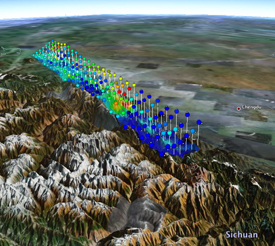Preliminary Result
05/12/2008 (Mw 7.9), East Sichuan
A. Sladen, Caltech
Location of Epicenter |
Amount of Slip on Fault
View in Google Earth (requires Google Earth) Colors show the amount of slip on diferent sections of the fault zone. Two views are shown (either view can be de-selected on the Google Earth sidebar):
|
DATA Process and Inversion
We used the GSN broadband data downloaded from the IRIS DMC. We analyzed 21 teleseismic P waveforms and 15 teleseismic SH waveforms selected based upon data quality and azimuthal distribution. Waveforms are first converted to displacement by removing the instrument response and then used to constrain the slip history based on a finite fault inverse algorithm (Ji et al, 2002). We use the epicenter location of the USGS (Lon.=103.270 ° Lat.=31.104°), while the strike (229°) and dip angle (33°) are taken from the GCMT solution.The solution is a unlateral rupture to the north-east over almost 300 km. The average rupture velocity is about 3 km/sec.
Result
.Cross-section of slip distribution

Figure 1: The big black arrow shows the fault's strike. The colors show the slip amplitude and white arrows indicate the direction of motion of the hanging wall relative to the footwall. Contours show the rupture initiation time and the red star indicates the hypocenter location.
Comparison of data and synthetic seismograms

Figure 2: The Data are shown in black and the synthetic seismograms are plotted in red. Both data and synthetic seismograms are aligned on the P arrivals. The number at the end of each trace is the peak amplitude of the observation in micro-meter. The number above the beginning of each trace is the source azimuth and below it is the epicentral distance.
Map view of the slip distribution

Figure 3: Surface projection of the slip distribution. The open circle are the aftershocks located by the USGS-NEIC in the 36 hours following the mainshock.
Comments:
This page is an update from the initial solution which included defective SH records.
Download
(Slip Distribution)| SUBFAULT FORMAT | CMTSOLUTION FORMAT | SOURCE TIME FUNCTION |
References
Ji, C., D.J. Wald, and D.V. Helmberger, Source description of the 1999 Hector Mine, California earthquake; Part I: Wavelet domain inversion theory and resolution analysis,Bassin, C., Laske, G. and Masters, G., The Current Limits of Resolution for Surface Wave Tomography in North America, EOS Trans AGU, 81, F897, 2000.
GCMT project: http://www.globalcmt.org/
USGS National Earthquake Information Center: http://neic.usgs.gov
Global Seismographic Network (GSN) is a cooperative scientific facility operated jointly by the Incorporated Research Institutions for Seismology (IRIS), the United States Geological Survey (USGS), and the National Science Foundation (NSF).
‹Back to Slip Maps for Recent Large Earthquakes home page
© 2004 Tectonics Observatory :: California
Institute of Technology :: all rights reserved